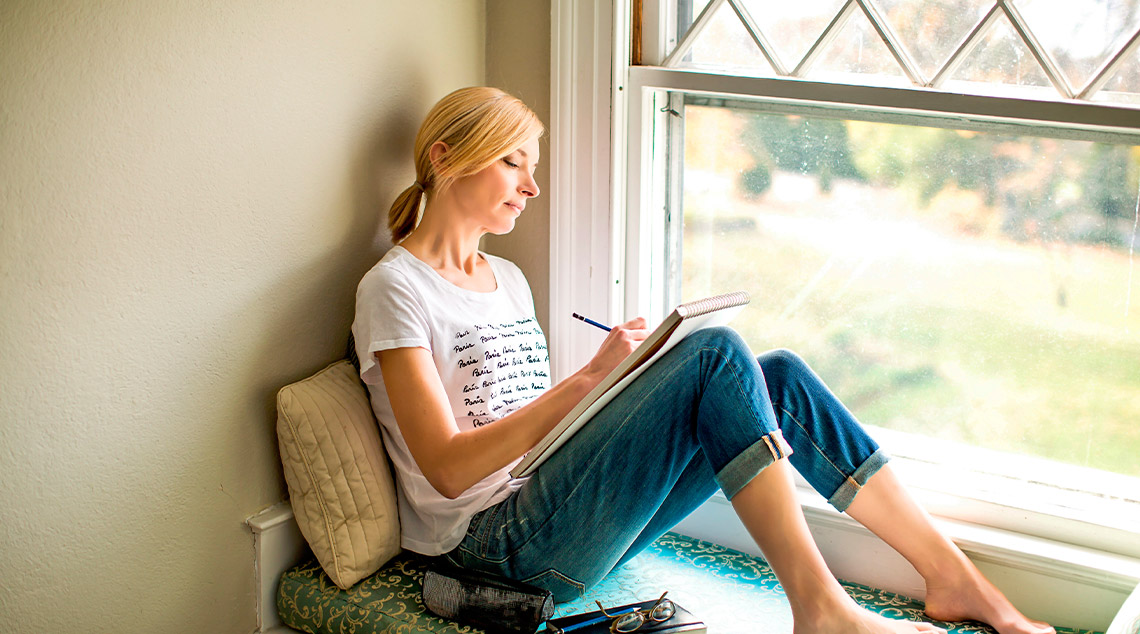5 creative ways to embrace messy journalling
Formerly an outlet for teenage angst, journalling is now valued by many as a form of self care and has even begun to take on an artistic flair.
Putting pen to paper became popular for many around the time wellness went mainstream, amplified by the Covid-19 pandemic.
Deemed a balm for modern life, a daily journalling routine brings many science-backed benefits for health and wellbeing.
The House of Wellness TV co-host Jo Stanley journals most mornings.
“I don’t think I’d be able to work productively throughout the day if I didn’t,” Jo says.
“It allows me to release the thoughts that are churning around in my head, or explore feelings I’m not quite understanding.”
Now the hobby is getting a ruffled makeover, with messy journalling gaining in popularity.
What is messy journalling?
Journalling can take many forms, including bullet journals, gratitude journalling, art journalling and the idea of “morning pages”, made popular by Julia Cameron in her book The Artist’s Way.
Messy journalling sits somewhere in the midst of these, a no-rules approach for self-expression and reflection where joy is at the heart of the ritual.
If sitting down and pouring out thousands of words is a bit daunting, messy journalling could be the right creative outlet for you.
Fusing writing and art, messy journalling offers the ideal combination of the two.
It’s a renegade against perfectionism, encouraging reflection – the kind that’s about freedom and process over the result.
“I think exploring our creativity is crucial to learning about who we are, how we can process the world around us, and really connect with the joy in us,” Jo says.
Benefits of journalling
Journalling, alongside art, is consistently linked to psychological wellbeing.
Studies suggest tuning into our creative side makes us happier and more mindful while reducing symptoms of stress and anxiety.
When words fail or are difficult to articulate, creating art is one of the easiest ways to express our feelings.
When engrossed in a creative activity, the brain enters a flow-like state, a construct cultivated by renowned psychologist Mihaly Csikszentmihalyi.
He proposes flow is the secret to happiness, and he may be right.
Research has also found the flow state is empirically linked to improved wellbeing.
Learn more about the benefits of doodling on The House of Wellness TV show:
Let go of your inner critic
Total Balance founder and life coach Kate James says it is common to feel intimidated by creative writing such as messy journalling.
“If we can detach from that inner critic and allow ourselves to play, to let the process be something fun, it’s amazing what it can do for you,” Kate says.
Kate recommends journalling to all clients who express a desire to untangle their thoughts.
“Writing things down is a really helpful way to make sense of a problem you’re struggling with,” she says.
She adds that clients report a slew of benefits, saying it helps them become more self-aware and self-compassionate while allowing them to turn inwards and feel more in tune with their thoughts and feelings.
“My instinct is that messy journalling gives people permission to be with the general messiness of life,” she says.
5 ways to embrace messy journalling
1. Scribble journal
First thing in the morning, take 10 minutes to write down whatever comes to mind, scrawling in loose and loopy handwriting.
Don’t worry if your writing isn’t legible – you can even write over the top of words again – the idea is to unburden the mind.
2. Erasure poetry
Cut a page out of a book and read over it, selecting any words that resonate with you.
Using paint, cover the other words on the page (leaving your selected words unpainted).
Your chosen words could make a poem, or simply be an expression of your feelings.
3. Watercolour circles
Using the wet-on-wet technique, where wet paint is applied to wet paper, or added to a wash of fresh wet paint, create watercolour circles in harmonious colours on a page.
When dry, bullet journal in each circle.
4. Celestial art
What’s your favourite thing about the night sky?
Make an artwork of it then write a haiku – a three-line poem that doesn’t have to rhyme – about why it’s special to you over the top of it.
5. Life collage
Choose a collection of recent photos, cut-outs from magazines or natural elements (such as pressed flowers from your garden) and make a collage to tell your story.
You could practise journalling daily, weekly or monthly.
More rituals and hobbies to boost your wellbeing:
- How Hirameki could help lower your stress levels
- 5 surprising health benefits of knitting
- Best morning rituals to start your day on the right foot
- Relax and unwind: 5 surprising hobbies to try
Written by Sarah Vercoe.






